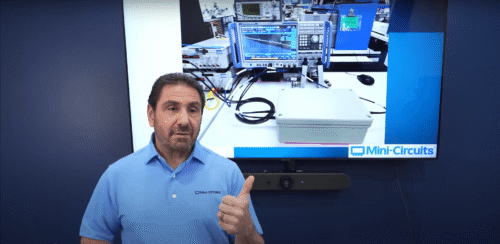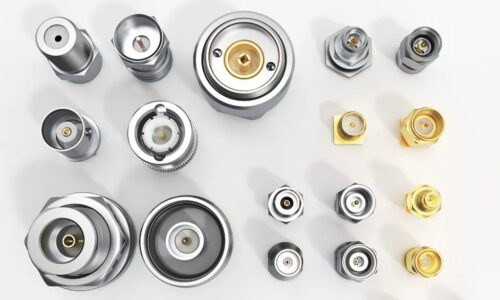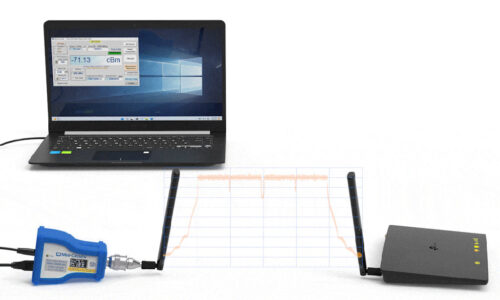Advanced Microwave Amplifier Models for Advanced Design System Simulations
Larry Dunleavy, Kevin Kellogg and Eric O’Dell, Modelithics, Inc., Tampa, Florida
Abstract
A tutorial overview is provided of nonlinear amplifier models available from Modelithics, with a focus on the enabling features of X-parameters models.
Introduction
Mobile and wireless communication has seen phenomenal growth over the past two decades. Faster communication with higher data rates has been the driving factor. To achieve this, the RF front end components have been continuously improved to meet the linearity and power requirements and a range of wireless standards have emerged, based on variations in frequency, modulation and power level requirements. The 0.7 GHz to 6 GHz band has been the mostly widely used frequency range for mobile and wireless communications using different standards such as GSM, CDMA, WCDMA, LTE, WLAN and WiMAX. The evolving 5G standard is pushing frequency ranges for emerging commercial systems upward to mm-wave frequencies as high as 86 GHz! Still, the bulk of near term 5G developments will likely be at the proposed bands of 28GHz and below.
Amplifiers are an indispensable component of the circuitry for wireless and microwave systems. They have been used in a variety of applications including mobile communications, microwave heating, jamming and electronic warfare networks, radar systems and satellite communications. There are many vendors that manufacture low noise amplifiers, power amplifiers, gain blocks and variable gain amplifiers for microwave wireless frequency bands below 6 GHz. An increasing number of products are now also being offered at higher frequencies, including many GaN MMIC based amplifiers, which offer higher power densities and higher frequencies than possible with Silicon and GaAs power transistor technologies.
When it comes to modeling, among the most advanced models available for nonlinear simulations is the X-parameter* model , , . This is conveniently supported within Keysight Advanced Design System (ADS) and Genesys. Another model that is available and predates X-parameters is the P2D model , . Both are behavioral models that are particularly useful for modeling productized die and packaged integrated circuit amplifiers, for which internal schematic details may not be available to the modeler. In the following treatment, examples of both models are discussed with an emphasis on the more powerful and accurate X-parameter model. X-parameter models can be generated either from an ADS nonlinear circuit simulation or from measurements taken on a suitably equipped test bench, such as one equipped with a nonlinear vector network analyzer (NVNA) like the Keysight PNA-X. Our focus in this article will be on measurement-generated models.
Available Models
Table 1 shows a list of currently available amplifier models included in the Modelithics® COMPLETE Library for ADS. These models are setup to enable both broad-band linear as well as nonlinear simulations of internally matched and unmatched amplifiers. Many of the models include noise parameter prediction and all allow some level of nonlinear simulations with the X-parameter model being most flexible and accurate. Several of these models are also available for immediate free use thanks to sponsorship from Mini-Circuits. Unique model features test conditions and simulation results along with measurement validations, are detailed in each models’ data sheet. The columns to the right of the product listing in Table 1 indicate various features of these models that use either the X-parameters or the P2D model. Note one Modelithics model, for the Qorvo RF2878, includes both X-Parameter and P2D model formats7, that can be selected by setting the user-defined parameter to 0 for P2D and 1 for X-Parameters. This model is available in Modelithics SELECT+ free sample library for ADS. While the focus in this article will be on models for ADS, X-parameters-based models are also available from Modelithics for Keysight Genesys.
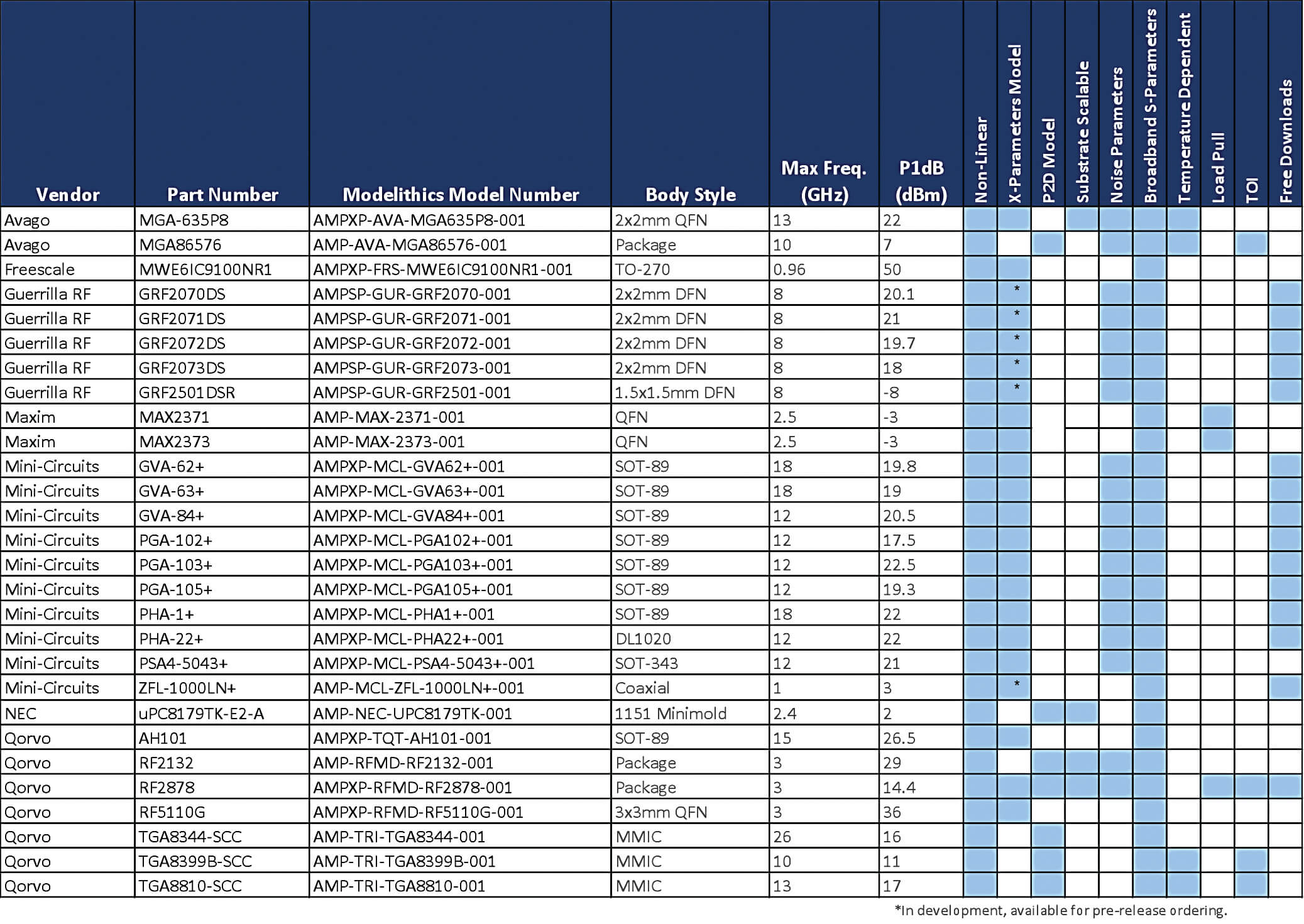
Table 1. Currently Available Models as Included in Modelithics COMPLETE Library for ADS
Understanding X-Parameters (In Brief)
X-Parameters are analogous to S-Parameters. They are both behavioral or “black box” models, in that there is no need for knowledge of internal circuitry, design or device type. However, whereas S-parameters provide for linear input/output relationships, X-parameters enable multi-harmonic nonlinear simulations. X-parameters can be easily ported to multiple EDA platforms, but like S-parameters performance one must be very careful about any extrapolations in frequency, power, or bias outside of the data range used to build the model. Modelithics X-parameter model datasheets give power, frequency, bias, and additional guidelines for model users.
As Figure 1 suggests a behavioral model provides a nonlinear mapping between a time domain (or multi-harmonic frequency domain) input signal x(t) and output signal y(t). Shown also is the Modelithics X-parameters-based model representation for a specific example amplifier model from Mini-Circuits. The available input parameters will vary with the model. The “model_mode” parameter is set to “1” for nonlinear X-parameter analyses and to “0” for small-signal S-parameter analyses. For practical reasons, it is easier to provide a broader-band small-signal (S-parameter-based) model to include out of band frequencies that may be of interest for stability and other purposes. The nonlinear model will generally be applicable to a narrower frequency band, including the main operating band of interest, since it is more “expensive” to develop in terms of test time and measurement complexity. This is especially true when measuring X-parameters of high power devices and circuits.
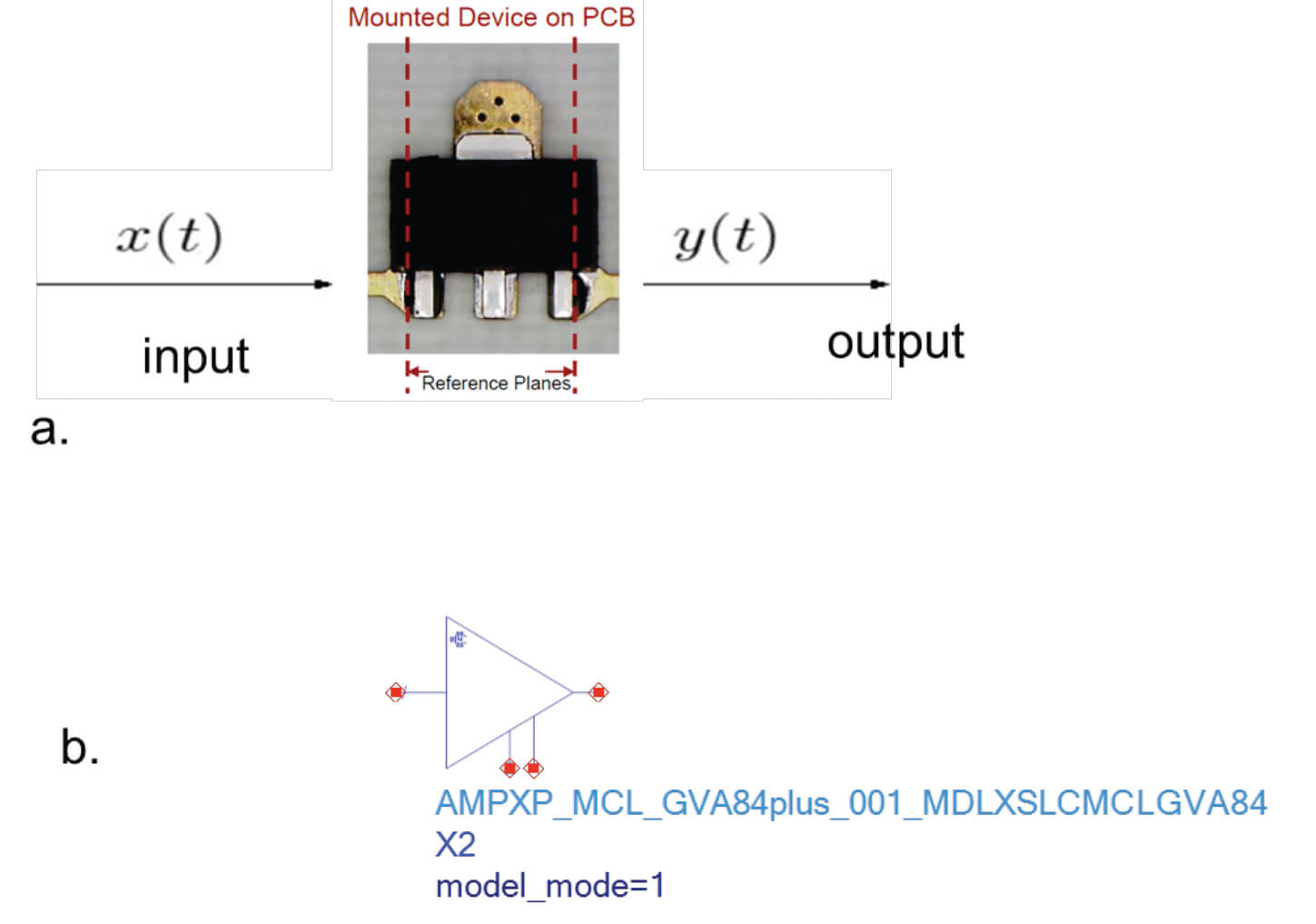
Figure 1. Amplifier representation as a “black box” model: a. packaged amplifier shown with desired mapping between output y(t) and input x(t), b. Modelithics ADS model for GVA-84+ amplifier from Mini-Circuits.
Whereas a deep dive on the mathematical formulation of X-parameters is beyond our scope here it may be helpful to review in brief one of the main defining equations shown below in Eq. 1.

Before we discuss the terms in Eq. 1, let’s recall the form of the S-parameter formulation that X-parameters simplify to in the low power linear extrapolation. Eq. 2 should look more familiar, and friendly!
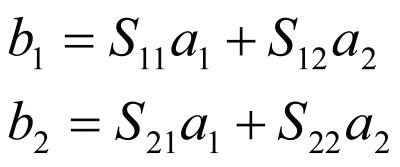
Starting with Eq. 2, b1 and b2 are the “reflected” voltage waves flowing out of ports 1 and 2, respectively, from a 2-port device, defined in terms of the S-parameters and the incident voltage waves a1 and a2. The indices 1 and 2 are port indices and all parameters are frequency dependent. This is a linear equation set and no new frequencies are generated and the “mapping” is assumed to be amplitude independent. The S-parameters are measured as ratios between reflected and incident waves, typically using a vector network analyzer, with no need to know the exact absolute power level of any of the waves.

Eq. 3 is equivalent to Eq. 2 with i and j being the input and output port indices, respectively. S-parameters models obey superposition that the combination of multiple small signal stimuli presented to the model will output the same response as the sum of the individual responses would. As such, S-parameters are easily and conveniently cascaded in a linear mode of operation.
Turning our attention to Eq. 1, in this case we have a nonlinear mapping between “reflected” or outgoing “b” waves, linear superposition does not apply and we have new periodic frequencies generated, cross frequency phase dependency, and the mapping is amplitude and frequency dependent at a single operating point. For this reason, there are four subscript indices used in the equation: i is the output port index, j is the output frequency (or harmonic number) index, k is the input port index and l is the input frequency (or harmonic number) index. This formulation is setup to accurately represent amplitude dependence under the variance of port 1 power as represented by the notation |A11|, which is the amplitude of the incident wave on port 1 at the fundamental frequency. The X-parameters are the functions that have superscripts (F), (S) and (T) and depend nonlinearly on |A11|. P is a phase term that, along with the magnitude-only dependence on |A11| of the X(S) and X(T) functions, is a necessary consequence of the assumed time invariance of the underlying system5. When measuring X-parameters with a modern nonlinear vector network analyzer, such as a suitably optioned Keysight PNA-X, we need to calibrate for and accurately measure absolute powers and the phase relationship at fundamental and all harmonic frequencies to be recorded. Moreover, for high efficiency amplifiers or when PAE is important, drain efficiency data can be included in the X-parameter model by carefully setting up the bias in the NVNA menu to establish communication between instruments and guaranteeing that the model is set up properly with measurement variables[i].
The motivated and mathematically inclined reader is referred to the cited references to dig deeper into understanding Eq. 1; however, some graphical insight is offered in Figure 2. For engineers who have a lot of familiarity looking at S-parameters for amplifiers, a first look at X-parameters plotted can be far from intuitive! Nevertheless, when we consider that X-parameters are a superset of S-parameters, we can start getting some comfort level by examining
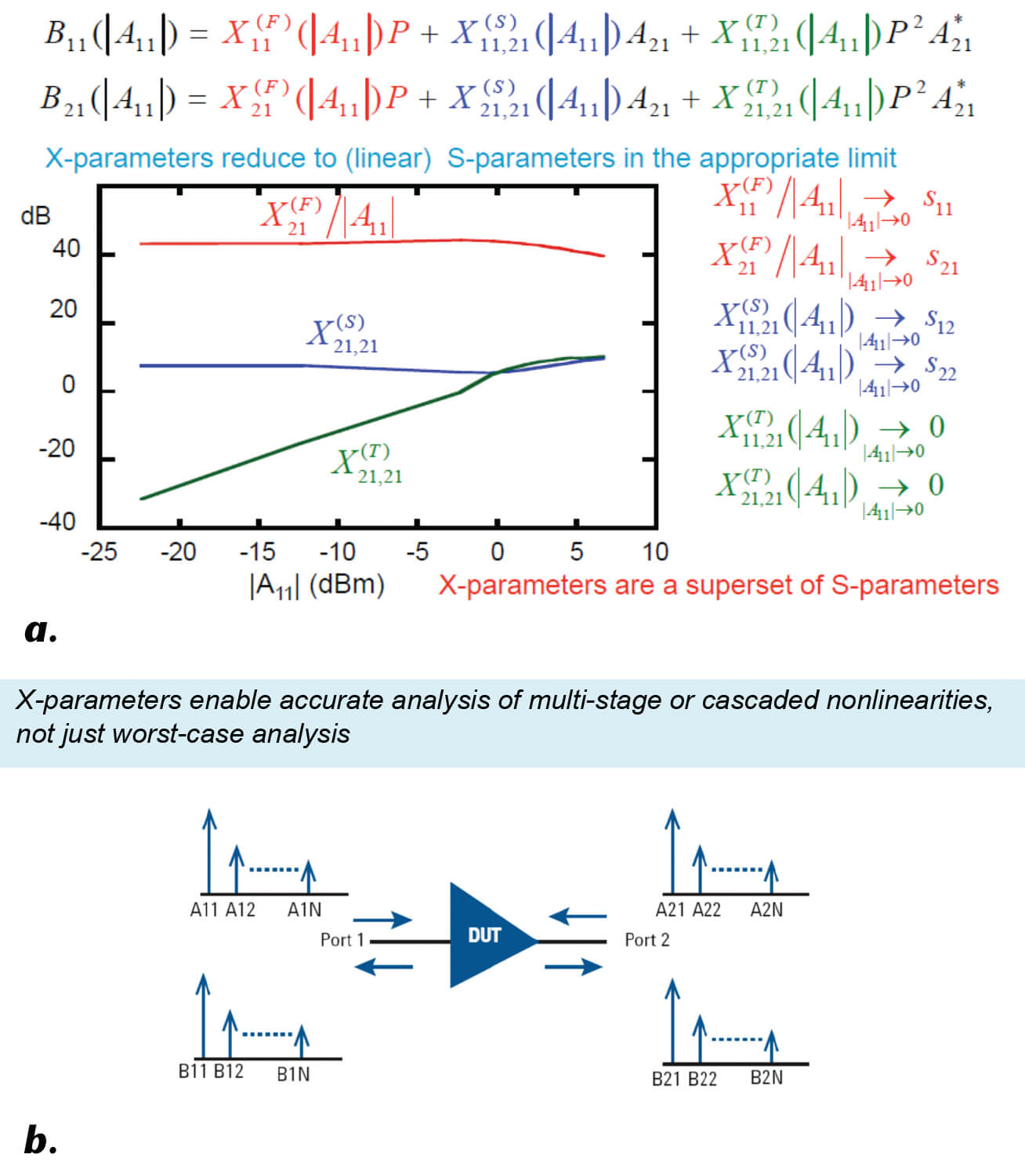
Figure 2a. Note how some of the functions can be presented in a way that directly correlates with the more familiar S11 and S21 parameters at low power.
Figure 2b, illustrates the multi-frequency, multi-port mapping that X-parameters enable between the nonlinear a and b waves. One of the key advantages to X-parameters is the way that harmonic signals with accurate harmonic amplitude and phase information are captured. This enables time domain waveform transformations as well as accurate analysis of cascaded nonlinearities. This contrasts with the worst-case system analysis performed by engineers for many years, using traditional spread-sheet methods.
Example Amplifier Models and Simulation Results
We now turn to presenting a few examples of X-parameters models selected from Table 1. We will start with the GVA-84+ model. Figure 3 illustrates some Modelithics data sheet information for this amplifier model.
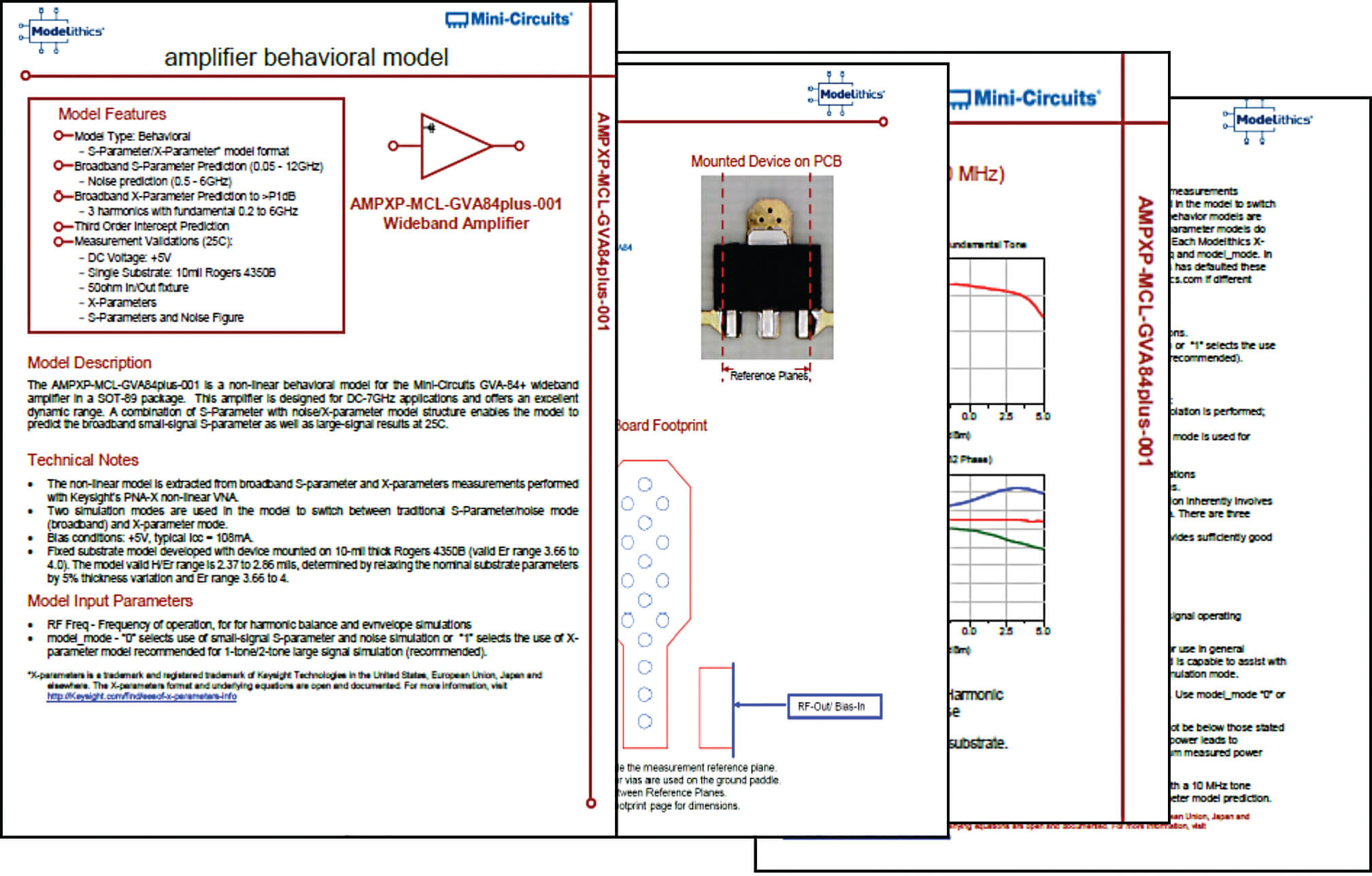
Figure 3. As an example, Modelithics information data sheet for GVA-84+ model contains 15 pages of information on model use, validations and detailed technical information.
Linear Simulations (model_mode = 0) – The model, which is setup the manufacturer recommended bias point of 5V and low power current of 108mA, has two model modes. Starting with linear mode, this model enables accurate S-parameter simulation over 0.05 to 12 GHz using “model_mode=0”. Noise parameter prediction is also provided for over 0.5 to 6 GHz, using the same mode. Figure 4 shows simulated and measured S-parameter and noise parameter results for the GVA-84+ amplifier model. One of the advantages of data-based behavioral models like S-parameters and X-parameters models, is that agreement to measured data can be exact “on grid” (that is when the simulation corresponds to measured data conditions used in generating the model.)

Figure 4. S-parameters (a.) and noise parameters (b.) simulation and measured results for GVA-84+ model using model_mode=0 setting and appropriate linear ADS simulation schematics.
Nonlinear HB Simulations (model_model =1) – Switching to nonlinear analysis, Figure 5 shows simulation results for a single-tone power swept harmonic balance analysis setup for the same amplifier model. According to the model data sheet, nonlinear analysis is provided for over the 0.2 to 6 GHz frequency range. As can be seen, from Figure 5 in the high-power region the fundamental power compresses as expected and harmonic power levels can be analyzed. Because we also get the phase information at multi-harmonics the nonlinear phase behavior (e.g. AM/PM) in the compression region can also be assessed.
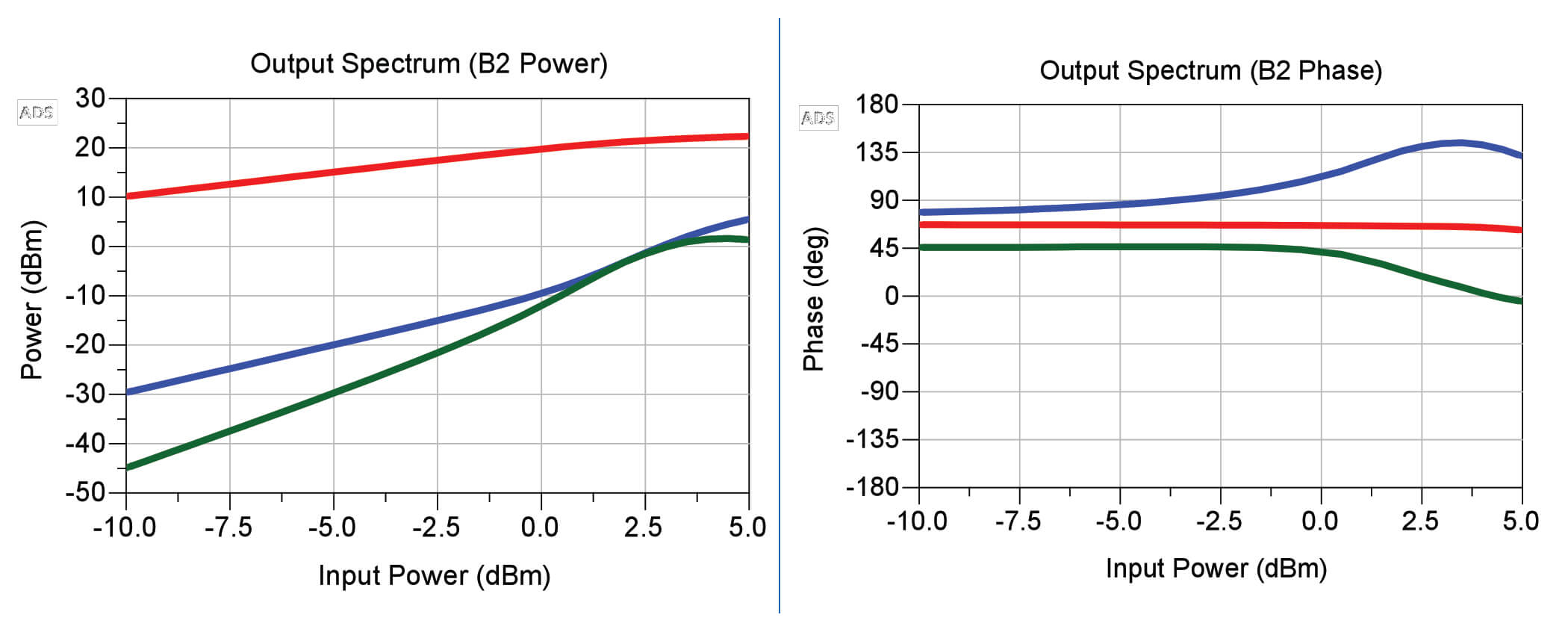
Figure 5. Multi-harmonic power sweep simulation for GVA-84+ amplifier example showing amplitude and phase at 2GHz for the b2j (amplifier output signal) wave at j= 1, 2 and 3, corresponding to fundamental (red), second (blue) and third (green) harmonic.
The results of using a somewhat more involved simulation setup for P1dB calculate across a range of frequencies are shown in Figure 6, with excellent correlation to the independently measured manufacturer’s P1dB data for this part.
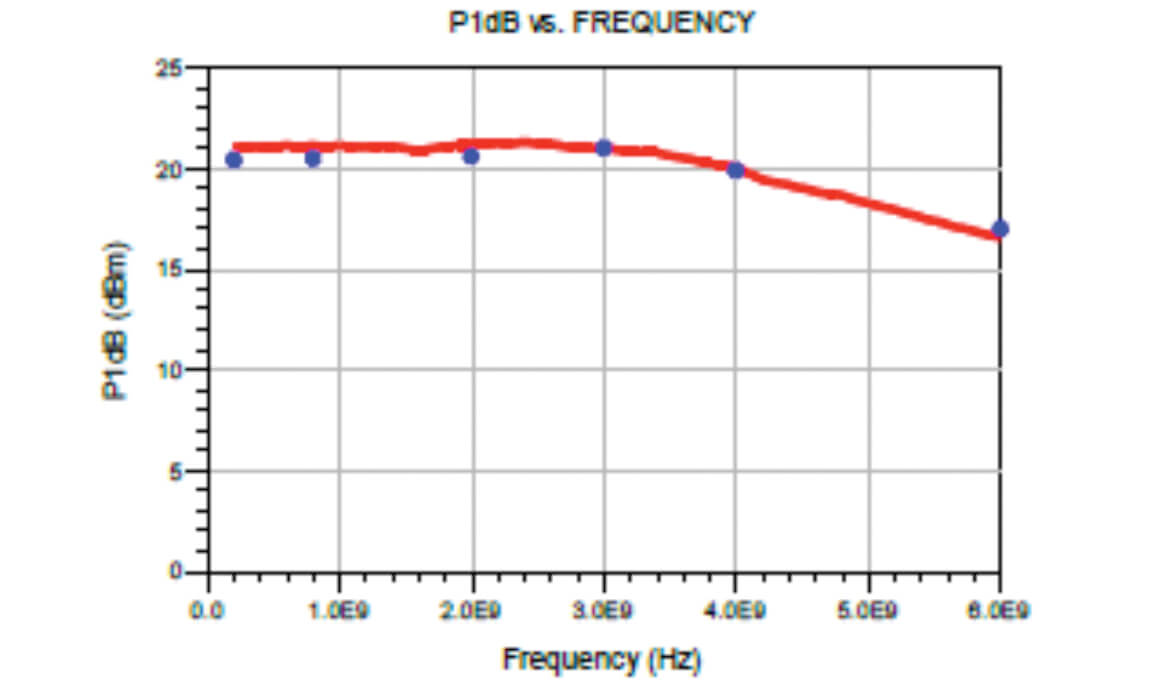
Another interesting example of the advantage of an X-parameter model over than that of an S-parameter model is one where superposition breaks down, such as two amplifiers cascaded as depicted in the schematic in Figure 7a with simulated results shown below in Figure 7b.
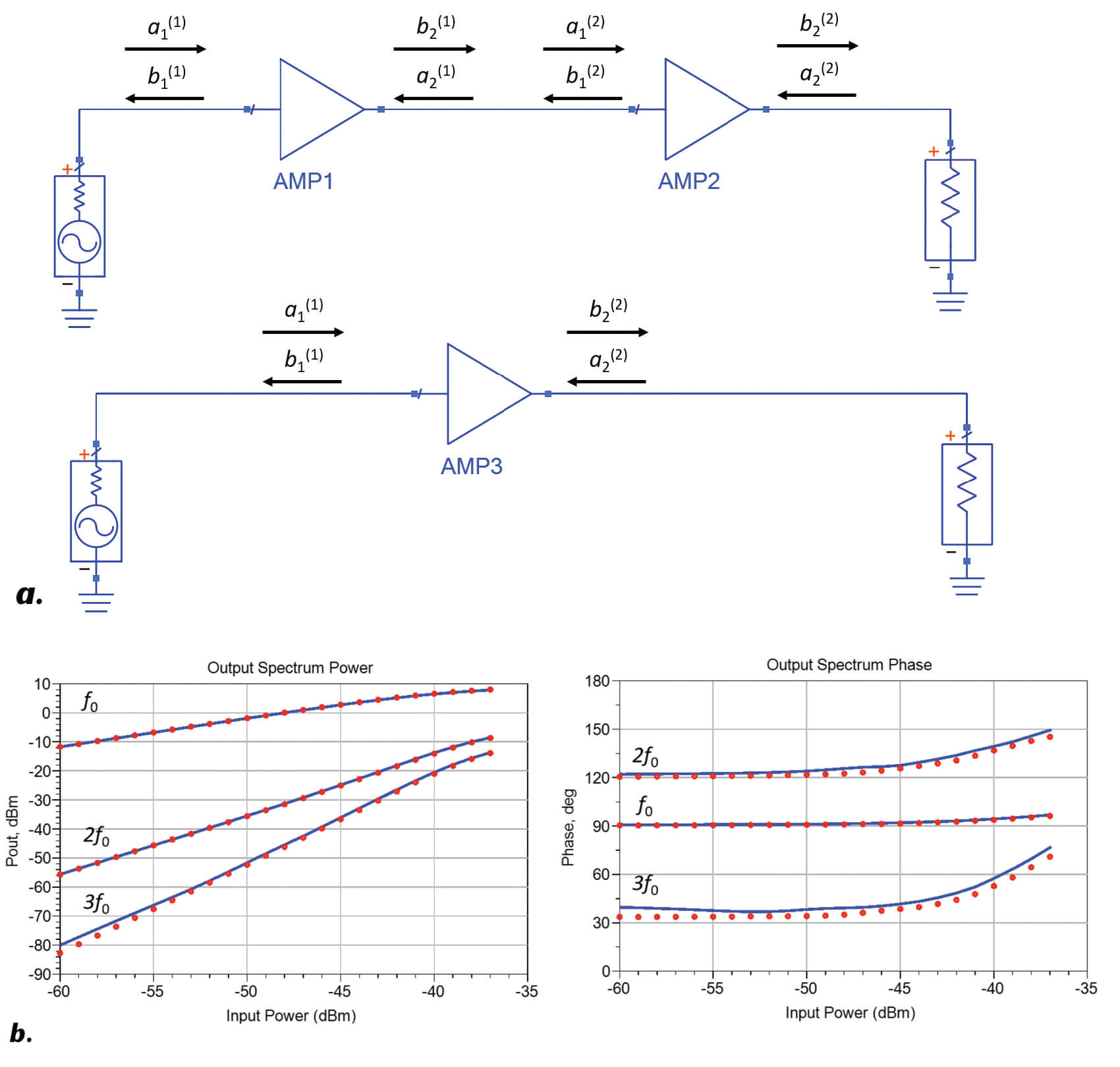
In this example, two X-parameter models of different Mini-Circuits XFL-1000LN+ amplifier units are cascaded back to back (AMP1 and AMP2). The results are then compared to a third X-parameter model (AMP3) where the cascaded amplifiers were treated as a single gain block and modeled together. AMP1 overdrives AMP2 at higher power levels, but unlike S-parameters, these X-parameter models are able to accurately predict the fundamental and harmonic spectra of the incoming and outgoing waves. This can be seen by observing the close correlation of the simulated results, verifying the accuracy of X-parameters with for proper calculation of cascaded non-linearities in both amplitude and phase.
Nonlinear Envelope Domain Simulations (model_mode=1) Another common amplifier figure of merit of interest is two-tone third order intermodulation (IM3) and third order intercept point (IP3) simulations. While there is a methodology for measuring X-parameters under 2-tone simulation[i], our scope here will be limited to X-parameters generated from more conventional 1-tone X-parameters test setups. That said, our experience in validations done so far is that quite good results can be obtained for 2-tone IM3 and IP3 simulations using 1-tone X-parameters models, with certain caveats also observed[ii].
Figure 8 shows that excellent results were obtained for this comparison between simulated and measured third order distortion. In this case, the measurements were made at Modelithics using a separate test setup from that used to generate the X-parameters model. The envelope domain can also be used along with the same X-parameters model type to simulate more complex digital modulations, such as CDMA.
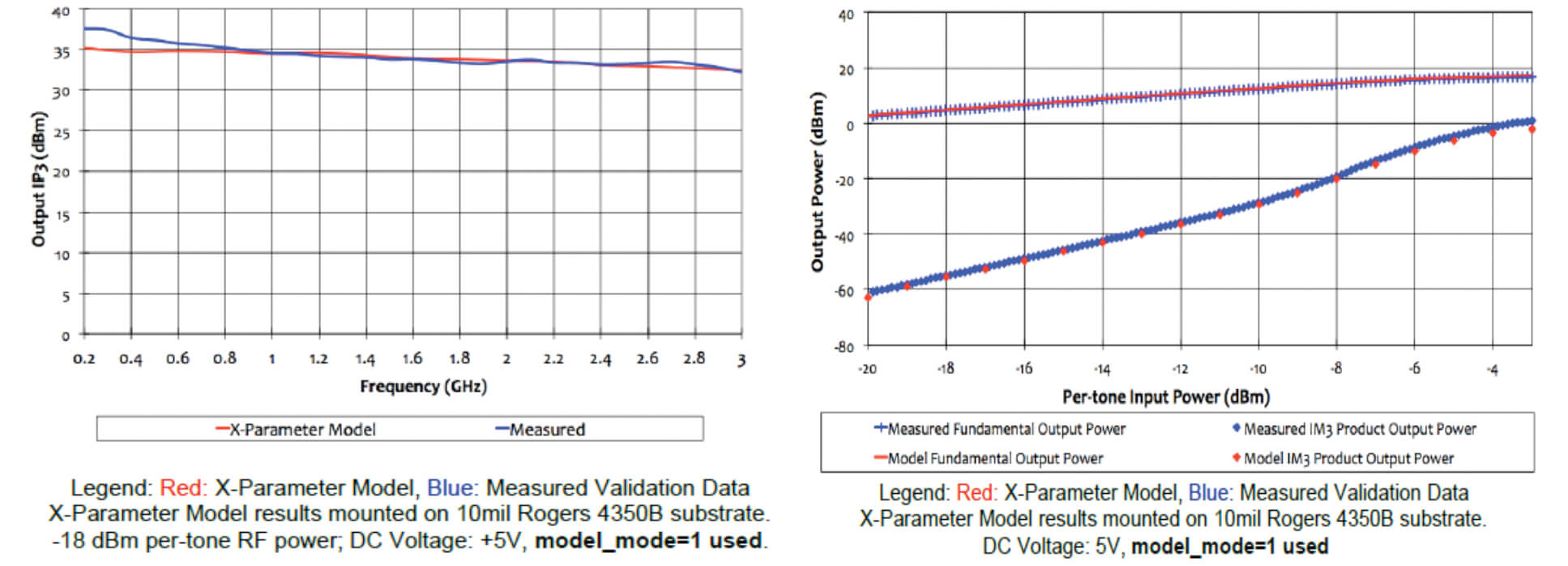
Load-Pull X-parameters Models
For the remaining examples we will switch go a different model. The GVA-84+ is a pre-matched amplifier that is matched in the vicinity of 50 ohms. Keysight recommends that X-parameters models are generally valid for a VSWR range of 2:1 as compared to the model extraction impedance. A solution for amplifiers requiring matching far removed from 50 ohms is “load-dependent” X-parameters8,9. On the test bench, this means we must vary the load impedance in some manner. We may add a passive load-pull tuner, prepare an active load pull measurement bench, or even a hybrid active approach. Within the test bench, we must be prepared in the simulator to also setup suitable matching impedances, that are different from 50 ohms. This was the case for the model to be described next. In addition to a load- tuner this bench had to be configured to handle higher powers than the unprotected PNA-X can handle and also be setup to capture bias current information in order to enable the model to simulate power-added-efficiency properly.
A few pages from the model information data sheet for the RFMD (now Qorvo) RF5110G amplifier are shown in Figure 9. As compared to the GVA-84+ amplfier described above, this part is a high efficiency, high gain power amplifier capable of over 3W of output power. The output is left unmatched so that the designer can optimize for his chosen bandwidth. The Modelithics model for this part can accurately simulate S-parameters over 0.1 to 3GHz (model_mode =0), while the nonlinear model (model_mode=1), operates at a subset of these frequencies. The model is actually extracted for applications in three bands, selected with a band select pull down menu. A manufacturer suggested application circuit was implemented for each band on custom test boards manufactured along with on-board calibration standards to de-embed the 50 ohm input/output transmission lines to the package edge. Excellent agreement is seen between simulated and measured results for load-pull countours and power swept gain, power and PAE are shown in Figure 10.
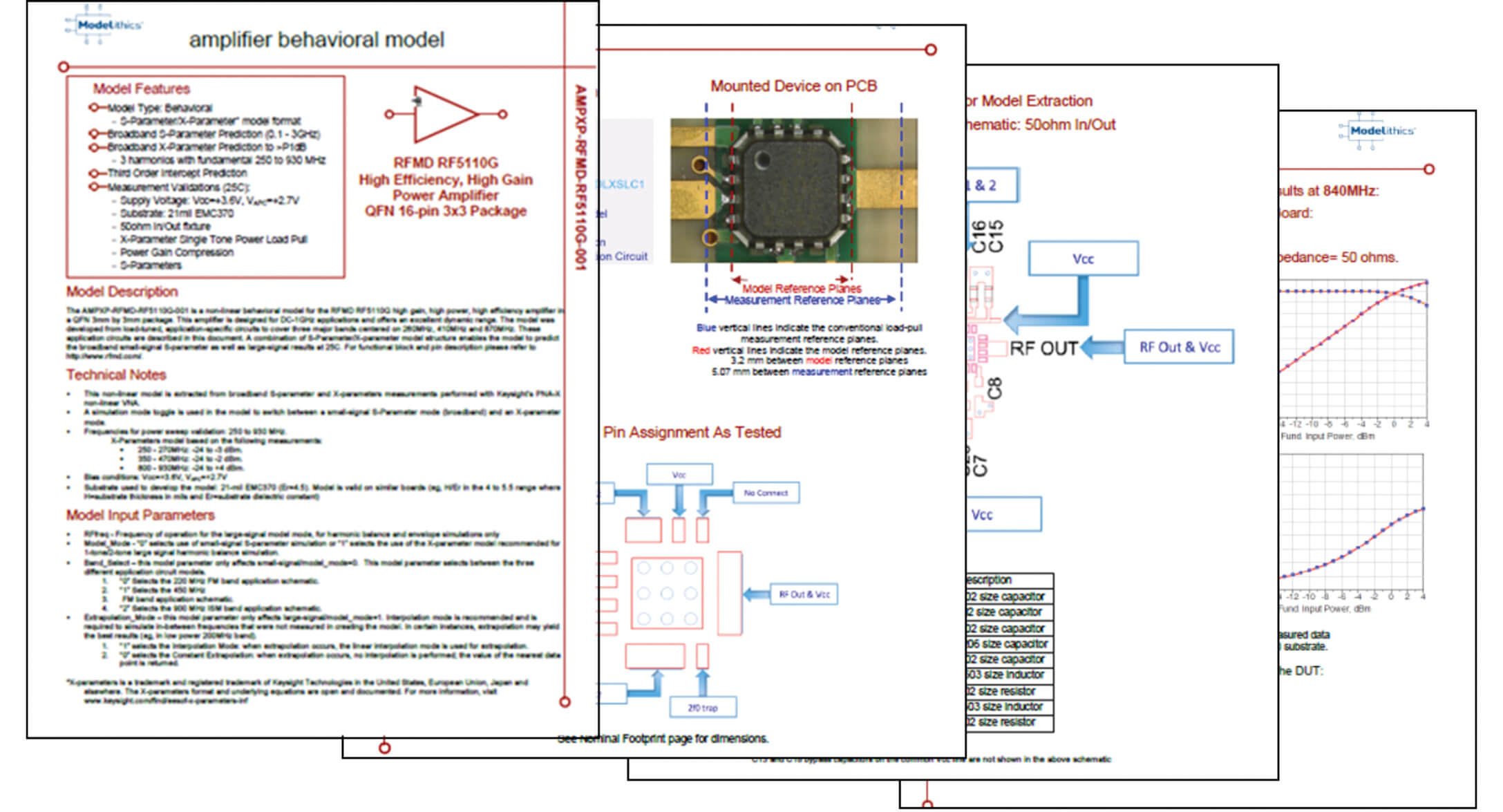
Figure 9. As an example, Modelithics information data sheet for RF5110G model contains 16 pages of information on model use, validations and detailed technical information.

Summary
A library of advanced nonlinear models for a range of amplifier products is available for use in Keysight ADS. Advanced features include accurate de-embedding to device or package terminals with the same model being usable for broad-band linear and noise (where applicable) simulations as well as harmonic balance and envelope domain simulations enabled primarily by X-parameters technology. X-parameters are an excellent model solution for amplifier modeling. Among other reasons it requires little or no detailed internal device information and allows the amplifier to be treated as a black box. When extracted properly, the result is a model that can be used for multi-stage nonlinear analyses and design optimizations of individual amplifier output or inter-stage matching circuits.
Information and simulations from example models were used to illustrate the type of documentation provided for each model along with a range of measurement validations showing excellent correlations are possible with nonlinear test data, even if derived from completely independent test benches and verifying test data not used as part of the model development data set.
Acknowledgements and Additional Information
The authors would like to thank Keysight Technologies for collaboration related to this work as part of the Keysight Solution Partnership program. In particular, we would like to thank Chad Gillease for his great technical support and Jose Civello of Keysight for his helpful editing comments.
A trial of Modelithics® COMPLETE Library for ADS can be requested at: https://www.modelithics.com/model. For access to the Mini-Circuits sponsored models, including the amplifier models discussed in this work see: https://www.modelithics.com/mvp/minicircuits. For designer convenience, several ADS workspace examples, including the schematic setups for results illustrated in this article are included in the Modelithics EXEMPLAR Library and Modelithics COMPLETE Library installations and also a longer application note version of this note can be downloaded from the literature area of Modelithics website[i].
[i] Modelithics Application Note 059: “Advanced Microwave Amplifier Models and X-Parameter Simulation Setup Examples for Advanced Design System Simulation.” Modelithics, Inc. https://www.modelithics.com/Literature/AppNote .
References


